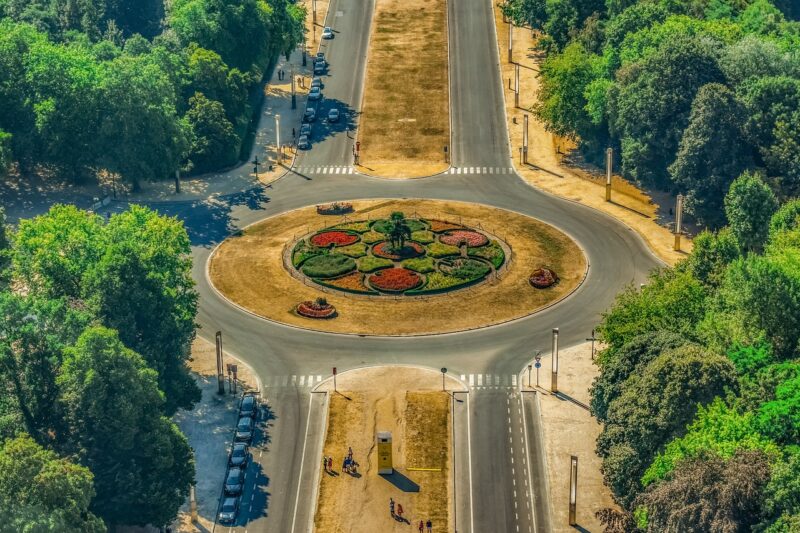Why Roundabouts Are Becoming More Common and How They Improve Road Safety
November 12, 2024

Roundabouts are increasingly dominating road networks across the globe. Once a rarity, they have become a preferred choice in city planning and traffic management. But why are roundabouts becoming more common, and how do they enhance road safety? This article delves into the rising prevalence of roundabouts, their numerous benefits over traditional intersections, and how they contribute to safer roads for all users.
1. Understanding Roundabouts
Before we explore their advantages, it’s essential to understand what a roundabout is. A roundabout is a circular intersection where traffic flows in one direction around a central island. Unlike traditional intersections that often feature stop signs or traffic signals, roundabouts simplify traffic flow, minimizing the need for complete stops.
Key Characteristics of Roundabouts:
– Yield at Entry: Vehicles entering a roundabout must yield to traffic already circulating.
– Counterclockwise Flow: Vehicles travel counterclockwise around the central island, reducing collision angles.
– Single Lane and Multi-lane Designs: Depending on traffic volume, some roundabouts feature one lane, while others may have multiple lanes
Understanding these principles helps clarify how roundabouts can improve traffic efficiency and safety.
2. The Rising Popularity of Roundabouts
Over the last few decades, roundabouts have gained traction as an effective solution to growing traffic challenges. Here are some reasons for their increasing popularity:
- Traffic Efficiency: Roundabouts can handle more traffic compared to traditional intersections. Studies show that they reduce vehicle delays, especially during peak hours, making them more efficient for urban planning.
- Land Use Efficiency: They occupy a smaller footprint compared to traditional intersections with traffic lights, allowing for more efficient use of land, which is especially valuable in urban areas.
- Cost-effective Maintenance: Roundabouts tend to require less maintenance than traffic signals and signs. This translates into cost savings for municipalities over time.
- Environmental Benefits: Reduced idling at roundabouts decreases fuel consumption and lowers vehicle emissions, contributing to more sustainable urban environments.
These reasons demonstrate why city planners are encouraged to incorporate roundabouts into new road designs as well as retrofit existing intersections.
3. How Roundabouts Enhance Road Safety
One of the primary motivations for implementing roundabouts is their ability to improve safety on the roads. The following points highlight how they contribute to fewer accidents:
- Reduced Collision Severity: Roundabouts significantly lower the likelihood of severe accidents. The most common types of collisions at traditional intersections—such as T-bone accidents—are reduced since vehicles travel in one direction and the angles of approach are less severe.
- Fewer Conflict Points: Roundabouts have fewer conflict points (places where paths of vehicles, cyclists, and pedestrians may intersect) than traditional intersections. A classic intersection has up to 32 possible conflict points, while a roundabout typically has only 8, significantly enhancing safety for all users of the road.
- Slower Vehicle Speeds: The circular nature of roundabouts encourages slower vehicle speeds. This reduction in speed decreases the chance of serious injuries and fatalities in the event of a collision.
- Improved Pedestrian Safety: Many roundabouts incorporate pedestrian crossings set back from the actual circular traffic, allowing pedestrians to cross one direction of traffic at a time. This design helps keep pedestrians safer as drivers are generally more focused on yielding to traffic already in the circle.
Research has consistently shown a reduction in injury crashes in areas where roundabouts have been implemented effectively.
4. Economic Benefits of Roundabouts
Beyond safety, roundabouts offer significant economic benefits that may appeal to city planners and local governments:
- Lower Crash-Related Costs: The reduction in both the frequency and severity of accidents leads to lower costs associated with legal claims, insurance, and medical expenses. This can save communities substantial amounts of money over time.
- Attracting Businesses: A well-placed roundabout can improve access to commercial areas, encouraging businesses to open in or move to locations that have enhanced road safety and efficient traffic flow.
- Increased Property Values: Areas surrounding roundabouts often experience increased property values attributed to improved accessibility and safety, creating a more desirable locale for residential and commercial developments.
These economic considerations further validate the transition to roundabout-centric designs in urban development.
5. The Implementation of Roundabouts: Best Practices
While the installation of roundabouts comes with many benefits, proper planning and design are vital for their success. Here are some best practices for implementing roundabouts:
- Comprehensive Planning: Engage traffic engineers in the planning stages to assess traffic volumes and patterns. Determining the capacity of the roundabout to handle peak hours is essential.
- Clear Signage and Markings: Appropriate signage to guide drivers on how to navigate the roundabout, including yielding rules, is crucial. Proper lane markings will also assist vehicles in navigating correctly.
- Educating the Public: Public education campaigns can help familiarize drivers with how to use roundabouts effectively. This could minimize confusion and increase compliance with yielding rules.
- Monitoring and Adjusting: Traffic patterns should be monitored post-installation, with adjustments made as necessary to optimize flow and safety based on real-world usage data.
By adhering to these best practices, municipalities can maximize the effectiveness of roundabouts, resulting in safer roads for all.
Conclusion
The rise of roundabouts within our transportation networks signifies a positive shift toward safer and more efficient roadway designs. By enhancing traffic flow, improving safety for drivers and pedestrians, and presenting economic benefits, roundabouts stand out as a solution for modern road challenges. As cities continue to grow and traffic volumes increase, roundabouts will likely become even more prevalent in the efforts to ensure safer roads for everyone.
Embracing roundabouts represents a proactive approach to road safety, efficiency, and community well-being. It is high time cities around the world prioritize their development as a standard feature in urban planning.







